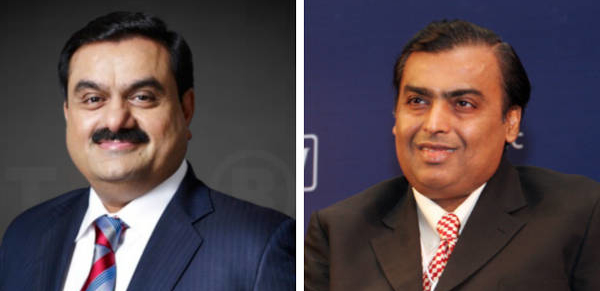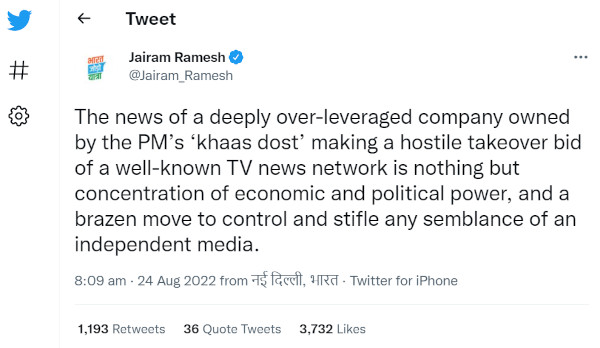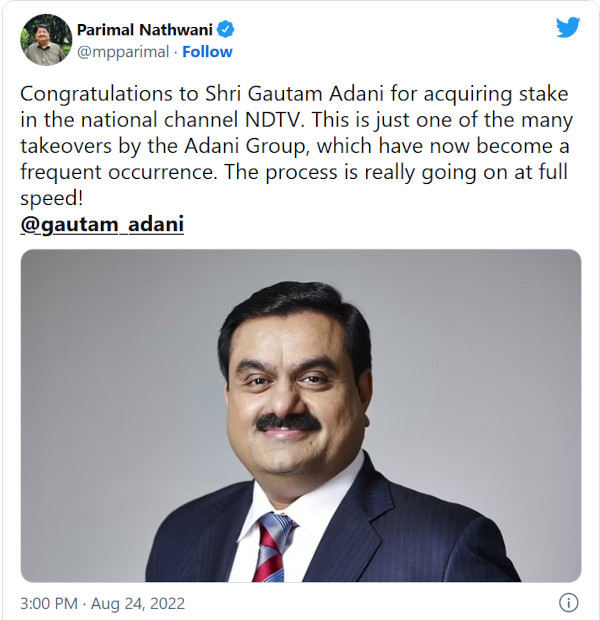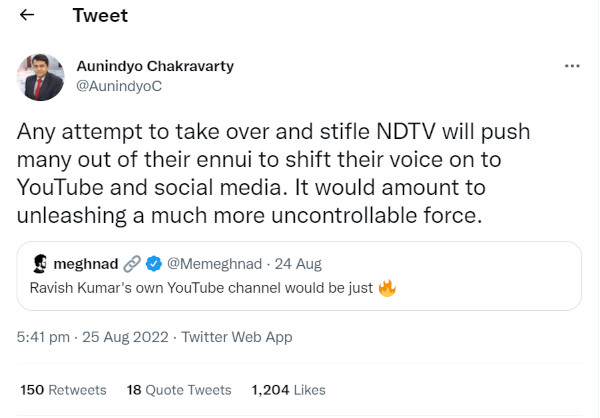[Prannoy Roy. Photo by World Economic Forum (CC BY-NC-SA 2.0), via Flickr]
(Editor’s note: This story is being updated to include fresh developments. If you’ve read this already, you can jump directly to the updates Click on here for the update on August 25, 2022, click here for the update on August 26, click here for the update on August 30, and click here for the update on August 31.)
On Tuesday evening, Twitterati was abuzz with the news that Adani Enterprises had mounted a takeover bid on NDTV, one of the country’s premier television channels and digital platforms, founded and owned by Prannoy and his wife Radhika Roy. While there has been persistent speculation around a possible Adani takeover of NDTV for the past several months, the current drama erupted without any warning. And it stretched well into midnight. At around 11:30 PM, nearly 1,600+ people had logged into a live Twitter Spaces conversation with Bengaluru-based stock market expert Deepak Shenoy. Questions came in thick and fast from both analysts and business journalists. Listeners were eagerly lapping up morsels of information and background around the takeover.
The saga started in 2006, when the Roys had taken a loan from Indiabulls Financial Services at high interest rates to fund an open offer. In 2008, buffeted by the global financial crisis, the Roys found themselves in a precarious position. They were unable to service the loan and ended up transferring the loan to ICICI Bank in 2008. But that move didn’t help matters either. In 2009 the Reliance group stepped in with a Rs 350 crore interest-free loan. In 2010, the Reliance group extended another Rs 53.85 crore, taking the total loan amount to Rs 403.85 crore.
The Reliance loan was funded through a firm that is in sharp focus now: Vishvapradhan Commercial Private Limited, or VCPL. In return for the loan, RRPR (a holding company owned by the Roys, which holds 29.18% shares in NDTV) offered convertible warrants to VCPL, convertible into equity shares aggregating to 99.99% of the fully diluted equity share capital of RRPR at the time of conversion, convertible at any time during the tenure of the loan or thereafter. The warrants were exercisable indefinitely—even after the loan had been repaid. So, Reliance had created latches on its investments in case the interest-free loan wasn’t repaid. Primarily, VCPL was just a shell firm, which owned exercisable warrants that could be converted into equity shares of RRPR plus the loan. In a reply to a query from the regulator, VCPL clarified that the source of its borrowings was Reliance Strategic Investment Ltd, a wholly owned subsidiary of Reliance Industries Limited.
Over the next 3 to 5 years, the idea was that RRPR and VCPL would look for a stable and reliable buyer for RRPR, who would maintain the brand and credibility of NDTV. While there were many suitors, none of the deals fructified. The Roys were in no position to pay back the original loan, even well beyond the 10-year tenure. But as long as the warrants weren’t exercised, the Roys were able to continue leading the venture without any real threat. (Since the details of the agreement between VCPL and RRPR are not in the public domain, the most authentic source for it is this recent SAT order of July, 2022.)
Over a period of 14 years, VCPL’s ownership moved from the Reliance group to one of their associates, Mahendra Nahata of the HFCL group.
It is this Nahata-owned entity which has now been bought out by AMG, an Adani Group company. And soon after taking over, AMG chose to exercise the options to convert their warrants into shares in RRPR, thereby triggering an open offer under the Takeover Code.
As soon as that happened, on Tuesday evening, the Roys wasted no time in firing their salvo. Within three hours of the Adani public statement, they put out a statement of their own, openly declaring that Adani had acquired control of VCPL without their consent.
Here’s the evolving situation: Nahata, as a Reliance associate, is now out of the picture. The safety envelope that the Roys enjoyed all along is now gone. And the couple find themselves in the crosshairs of one of the most aggressive businessmen in the country: Gautam Adani. The raider is now at their very doorstep. Will the Roys blink?
The multiple scenarios
There have been many such acrimonious and long-drawn takeover battles in the history of corporate India, including L&T’s takeover of Mindtree and its battle for control with the founders of the Bengaluru-based IT firm in 2019. But this particular case is somewhat unique. For one, unlike the Mindtree founders who collectively had around 4% stake, Radhika and Prannoy Roy still own 61.45% stake in NDTV.
For the moment, AMG, the Adani group company leading the charge, does not own a single share of NDTV. Yet the current Takeover Code required them to make an open offer as soon as they bought all the shares of VCPL, and chose to exercise the warrants and acquire equity shares. The Adani deal with VCPL was consummated on Tuesday. And ironically, the announcement about the deal came from JM Financial, a leading investment bank known to be close to Reliance. (Here’s the JM Financial announcement.) Why it chose to helm this deal and advise the Adani group, Reliance group’s biggest rival, is equally intriguing. We’ll come to that in a bit.
In their statement and disclosure to BSE, the Roys have provided a glimpse into how they plan to defend this seemingly hostile takeover, if the matter heads to court. They’re relying on a clause in their 2009 agreement with VCPL. It clearly states that VCPL and its affiliates cannot purchase shares of NDTV, which will increase their holding to more than 26% in NDTV, without the consent of the promoters. On its part, AMG, the Adani group company, has served notice on RRPR, the holding company owned by the Roys, to convert a part of their warrants into RRPR shares, amounting to 99.5% of RRPR (and 29.1% of NDTV) and transfer the shares in their name within 48 hours. (This is Adani’s disclosure to BSE)
For the moment though, the battlelines are clearly drawn. By Thursday evening, if the Roys stoutly push back and refuse to allot the new shares and transfer 10,000 shares of their own to AMG, it could open a can of worms for Adani. It isn’t just about a loss of face. They could also face uncomfortable questions from the markets regulator SEBI on why it chose to rely on stealth, and not engage with the promoters, before triggering an open offer. In that case, the only resolution available for the Adani group is to approach the courts. They could take recourse under the Indian Contracts Act, which governs all commercial deals and agreements in the country.
There are a range of scenarios that now present themselves. The ball is now in Roys’ court. It remains to be seen what the Roys are likely to do by the end of day on Thursday.
One, they could either walk away into the sunset by transferring 99.5% stake in RRPR to AMG. If that happens, the open offer will go through—and Adani could easily take control of NDTV.
Two, they could choose to respond directly to the Adanis and the bourse, explicitly turning down the offer to transfer shares. That could immediately trigger a legal battle, with the Adani group hauling them to the High Court.
And three, it is entirely possible that the lawyers for the Roys could simply ask them to ignore the 48 hour deadline imposed by the Adani group. Till such time the Roys refuse to allot the new shares and transfer their own shares, this battle is unlikely to wind down anytime soon. To raise the pitch, the Roys have raised the issue of independent journalism—and their refusal to compromise. “NDTV has never compromised on the heart of its operations—its journalism. We continue to stand by that journalism,” the statement averred.
Now, the real issue is this: are the Roys prepared to stave off a hostile takeover by one of the most powerful business groups in the country, known for their proximity to Prime Minister Narendra Modi? There’s a possibility that we might get some indication of that stand by Thursday evening. But again, they could also look to buy time and make the Adani group sweat.
In essence, this is the current state of play. Even as we wait for the full story to unfold, here are a couple of interesting sidelights.
Why did the Nahata-Reliance combine opt out?

[Gautam Adani (left; photo by Chirag200201, CC BY-SA 4.0, via Wikimedia), and Mukesh Ambani (photo by World Economic Forum from Cologny, Switzerland, CC BY-SA 2.0, via Wikimedia Commons]
If one sees Nahata as a Reliance associate, it is indeed an intriguing question. There are two questions that would have been on Mukesh Ambani’s mind. Ever since they did the deal with RRPR, both the Roys and the Reliance-Nahata combine have faced close scrutiny from the markets regulator. It has resulted in bitter, protracted court battles with SEBI and with SAT. The regulator had taken the view that both the Roys and VCPL should have disclosed the transaction since it amounted to a change in management control.
In July this year, the SAT finally delivered its ruling that there was no need for VCPL to make an open offer, overruling the decision of G Mahalingam, whole-time member at SEBI, who had looked into whether VCPL had triggered the Takeover Code back in 2009. There is speculation that SEBI is looking to challenge the SAT verdict. And in case it wins, VCPL would have to make an open offer. It simply made no sense to put up more money for NDTV.
With the Network18 acquisition, Reliance has already secured its position in the media and entertainment business. Especially with its new IPL bid, the Ambanis had articulated a new vision for digital media and telecom, in partnership with James Murdoch. On the other hand, NDTV was turning out to be a distraction. For over 14 years, there was no return on the capital it had invested. And the asset held no strategic value for Reliance either. It is likely that letting go of VCPL may have actually made more commercial sense than holding on to it. Even if it meant offering a foothold and a new platform for its biggest rival in the media business.
The heat is on
That this announcement would raise the political temperature in the Capital was a given. Almost on cue, the Congress has capitalised on the moment by portraying the move as a way to stifle independent media. Its general secretary Jairam Ramesh put out a tweet describing the news of a hostile takeover as nothing but a concentration of economic and political power by PM’s ‘khaas dost.’

On its part, the Adani group has already sounded the victory bugle. “This acquisition is a significant milestone in the journey of AMNL’s goal to pave the path of new age media across platforms,” the press release quoted Sanjay Pugalia, CEO, Adani Media Networks Limited (AMNL).
Ironically, Adani received support from an unexpected quarter via Twitter: from Reliance’s director corporate affairs, Parimal Nathwani.

The Adani group has disclosed that it will fork out around Rs 113 crore to acquire VCPL from the Nahatas. While that might seem like small change, compared to many of his other bets, one thing is for sure: the NDTV deal could easily be one of Gautam Adani’s most high profile deals.
And as for the Roy family, they’ve been ensconced in board meetings in the capital most of Wednesday, searching for a ray of hope in a rather sombre and dark environment.
Update: August 25, 2022
One day after Adani group’s dramatic announcement of its purchase of VCPL and the resultant open offer, Prannoy and Radhika Roy have fired another salvo by responding through RRPR, their holding company.
In a disclosure to BSE on Thursday morning, RRPR pointed out that a SEBI order of November 27, 2020, restrained the two founders Radhika and Prannoy Roy from dealing in securities for two years. As a result, the letter clarified, the proposed acquirer in this case—AMG Media Networks—needed to take prior SEBI approval in order to secure “99.5% interests in the Promoter Group Vehicle (in other words, RRPR), since this would consequently lead to the acquisition of voting rights in respect of 29.18% of the issued share capital” in NDTV Ltd by the target company, AMG Media Networks. In their disclosure to the stock exchange, RRPR said it had asked its bankers to return the Rs 1,99,00,000 deposited in their bank account by VCPL. Here is the copy of this first disclosure and the other today.
Simply put, the Roys have bought extra time to review their strategic options. Any delay till November 26 means that the Adanis will not be in a position to immediately start the open offer and mount a possible takeover.
Also, it raises another important question: given that the SEBI order of November 2020 was an important document already in the public domain, wasn’t Adani’s merchant banker—JM Financial—duty bound to point it to their client, Adanis? It remains to be seen how SEBI views this anomaly.
Either way, this puts back Adani’s fast track process for the open offer. That’s because the Adani-owned VCPL does not own a single share in RRPR till date. With this new twist, it will not be possible for the Adanis to head to the courts either.
The best case scenario for the Adanis is to approach RRPR again on November 28, 2022, with the money and seek the conversion of warrants and the transfer of RRPR shares from the Roys to VCPL.
That, in turn, means the Adanis may need to approach SEBI for approval to extend the timeline for publishing the detailed public statement, the next logical milestone in the takeover process. SEBI requires the acquirer to make a detailed public statement under Section 13(a)(4)(page 44) of the SEBI Takeover regulations in this prescribed format within five working days after its open offer public announcement, by next Tuesday.
In case Adani chooses to approach SEBI, how the regulator reacts, remains to be seen. That’s because Adani did not take consent from RRPR before commencing the open offer, despite the fact that there is such a clause in the 2009 loan agreement. Nor did it take cognisance of a prior SEBI order, which was in the public domain all along, which restrains the Roys from dealing in securities.
No later than two days before the detailed public statement of the open offer, the acquirer, in this case, the AMG Media Networks, is required to open an escrow account for Rs 123 crore under Regulation 17(1) page 48) as a security for performance of their responsibility. After which, the merchant banker issues the detailed public statement. All of this process is likely to get pushed back.
There is one other issue: It is being speculated that SEBI had planned to challenge the SAT order of July 2022. RRPR, VCPL and the Roys were jointly a party to this hearing. SAT ended up overturning the SEBI order insisting that VCPL make an open offer. This is well before the Adanis bought out the Nahata stake in RRPR. According to this story in The Hindu Business Line, SEBI officials are concerned that the verdict could set a precedent and promoters of listed companies may secure a loan by issuing unlimited convertible instruments at pre-negotiated price. SEBI is required to file its appeal in the Supreme Court within 60 days of the SAT order being passed (July 20, 2022). It is widely speculated that the unseemly rush shown by Nahata and Adani to complete the acquisition of VCPL could be linked to this SEBI move to appeal the SAT order in the Supreme Court.
Now, here’s the moot point: what will the Roys finally do on November 27, after the SEBI ban ends? That is still unknown. That allows enough time for the two parties to thrash out an amicable outcome, which could mean better terms for the founders. On the other hand, the developments of the last two days also suggest the possibility of a strong fightback by the Roys. The next chapter of this takeover battle is waiting to be written.
Update: August 26
Drawing the battlelines
Till end of day Thursday, we didn’t quite know which way the battle for NDTV between Gautam Adani and the owners, Prannoy and Radhika Roy, would head. But now we do.
The die was cast on Friday morning, when Adani Enterprises put out two separate disclosures to the Bombay Stock Exchange and the National Stock Exchange, one addressed to NDTV and the other to RRPR. (If you want to study the documents, our Dig Deeper section at the end has the links to the disclosures and more.)
Shorn of legalese, here are six main points that one can derive from the two disclosures:
1. The Adani Enterprises’ disclosure refuted the main thrust of the NDTV letter sent to them on Thursday, calling it “baseless, legally untenable and devoid of merit.” Namely, that the two year SEBI ban on the Roys from dealing in securities till November 26, 2022, should have no bearing whatsoever on the conversion of warrants into equity shares of RRPR.
2. Their main argument: the SEBI ban did not apply to RRPR, the Roys’ holding company. Hence, RRPR was contractually obliged to honour its obligations. And the SEBI order did not in any way impede VCPL’s warrant exercise notice.
3. It also said VCPL did not agree with RRPR’s suggestion that it needed SEBI’s written approval before the warrants could be exercised.
4. Finally, it said that any attempts by RRPR to return the Rs 1,99,00,000 deposited in RRPR’s bank account towards the payment of 19,90,000 equity shares would have no effect on the warrant conversion exercise. In fact, by depositing the money and serving the warrant conversion notice, it has asserted that the process of warrant conversion has been completed from their end.
5. While it did not share the actual letter, the Adanis said they had written to RRPR responding to its letter.
6. In their letter to NDTV, Adani Enterprises confirmed that they had asked for all information/documents to support its open offer process. And it also confirmed that NDTV had agreed to pass on the details in compliance with SEBI Takeover regulations.
The beginning of the legal battle
So what’s the upshot of this new development?
1. Legal experts reckon this last letter is a clear signal that the Adanis are preparing the ground for a legal case—and are likely to move the High Court as early as next week. They may have given RRPR two days to respond.
2. It is still not known if RRPR will respond to this latest mail. If they so choose, the Roys could ignore it. After all, they have already stated their position. However, it is worth reminding that nowhere have they stated their refusal to honour their contractual obligations on the warrant conversion. They have merely suggested that the Adanis seek SEBI’s written approval before they are in a position to carry out the warrant conversion exercise.
3. Clearly, there is a difference of opinion between RRPR and the Adani group on the exact ambit of the two year SEBI ban imposed on the Roys, via its order of November 27, 2020. The SEBI order prohibits them from “buying, selling or otherwise dealing in securities, directly or indirectly, or being associated with the securities market in any manner whatsoever”. RRPR believes that this is all-compassing and precludes them from going forward with the conversion of the warrants, as sought by VCPL. The Adani group, however, does not accept RRPR’s legal position.
4. Now, it appears that the only way to resolve this issue is to take recourse to the Indian Contracts Act or The Commercial Courts Act, approach the High Court and ask it to adjudicate. Interestingly, the Adani group has indicated they are not interested in engaging with the markets regulator, as suggested by RRPR.
5. There may be a reason for the Adanis to stay away from SEBI. That’s because the Roys have a matter pending with the Securities Appellate Tribunal (SAT), which is hearing their appeal against the ban and the disgorgement of undue gains. It is reasonable to expect that if the Adanis sought SEBI’s intervention, the regulator could maintain that the matter was sub-judice—and they could in turn direct them to SAT. The next SAT hearing on the Roys case is scheduled for September 29, 2022. And it isn’t yet clear if the matter will get resolved at the next hearing.
6. The Adani move to approach the High Court may not result in any quick resolution. On the contrary, it could end up as a protracted legal battle. The courts are unlikely to adjudicate swiftly, until they have heard the arguments from both sides. And that could also take several months, sometimes even a year or two.
7. If this takeover battle gets bogged down at the courts, the Adani juggernaut could find itself halted in its tracks. And given the excruciatingly slow pace of the judicial system, both parties may need to hunker down for the long slog ahead.
8. Now, if the Adani group hopes to continue pursuing their open offer process, albeit with relevant caveats that they have moved the courts to clear the roadblocks, they could still do so. The deadline to file the detailed public statement comes up on Tuesday next week—and that will be closely watched to see what the Adani group does next.
Postscript: As expected, the NDTV case has aroused passions and emotions from both sides of the fence. The Roys are seen by many as pioneers and also the last bastion of independent journalism. Two days ago, the Delhi Union of Journalists put out a strong statement protesting against the “hostile takeover”—and the implications for the cause of independent journalism.
Aunindyo Chakraborty, a former senior managing editor at NDTV, reactivated his Twitter handle to put out a thread in support of the Roys—and their role in preserving the newsroom and protecting the careers of several hundred journalists.

Equally, for others, the Roys are an embodiment of the culture of access journalism in the Congress era, and the heady mix of politics, power and media in Lutyens’ Delhi, which the Modi era took on soon after assuming power in 2014.
Here’s one such commentary by Santosh Balakrishna in Dharma Dispatch, an online platform, which equates the NDTV takeover to an attempt to “drain the swamp”.
Dig Deeper:
Update: August 28
Rajdeep Sardesai shares memories from the early days of NDTV
Update: August 30
On cue, JM Financial, the merchant bankers appointed by the Adani group, submitted a detailed public statement (DPS) in the run-up to the open offer for public shareholders of New Delhi Television (NDTV) this morning. It said the open offer is tentatively likely to open on October 27, subject to the regulator's nod.
You can access the document here (pdf).
The next stage: the draft letter of offer, which falls due on September 6. On Monday, in anticipation of the open offer, NDTV had announced that it was pushing back its AGM by a week, from September 20 to September 27.
Meanwhile, the shares of NDTV have been galloping ever since the Adani group made an open offer to acquire an additional 26% in the television and digital news company on August 23. This IANS report in Business Standard says that on Tuesday, at the BSE, the NDTV scrip, with a face value of Rs 4, opened at Rs 467.25 and hit the upper circuit. The scrip had closed at Rs 445 on Monday. Incidentally, the 52 week low price for the scrip was Rs 72.
Update: August 31
In the run-up to the open offer, NDTV has made another important disclosure to the bourses late evening on August 31. It said founders Prannoy & Radhika Roy has informed the company about a letter that RRPRH, the promoter holding company, had written to VCPL about a pending Income Tax matter from 2017.
This affects Vishvaparadhan Commercial Pvt Ltd (VCPL)’s decision to convert warrants into equity shares, issued by RRPRH.
So what does the disclosure say?
1. According to the proceedings initiated by the Income Tax authorities in 2017 and notified in 2018, RRPR’s shares will remain attached till such time the authorities complete their reassessment.
2. As a result, RRPRH will require prior approvals and clarifications from the Income Tax authorities before VCPL’s warrant conversion can go ahead.
3. RRPRH has urged VCPL to join its application to the Income Tax authorities in this regard.
4. The Income Tax attachment order relates to the loan agreement between VCPL and RRPRH in 2009. In 2017, the Income Tax authorities issued an order based on the premise that when RRPRH had transferred its controlling interest in NDTV to VCPL, it contended that an estimated Rs 175 crore capital gains tax was payable, arising of that sale. The matter is still being heard.
5. However, the SAT order of July 20, 2022, among other things, maintains that “no direct or indirect control of NDTV by VCPL. The transaction structure does not lead to a conclusion that VCPL has acquired direct or indirect control over NDTV.”
6. As a result, Income Tax Authorities will need to
“clarify whether in light of the SAT order, the provisional attachment will continue to operate on RRPRH equity shares held in NDTV.”
7. The RRPRH letter also states that “as individuals, Radhika and Prannoy Roy may individually require independent approval, under section 281 of the Income Tax Act, from the Income Tax Authorities, to deal with any assets, including indirect shareholding in NDTV, arising from sub judice (impugned) orders.”
How does this impact the NDTV takeover story so far?
Quite simply, the Income Tax case remains yet another unresolved matter that will need to be closed. The Income Tax department will need to clarify that it has no objection to the warrant conversion moving ahead. Now, this needn’t be viewed as a showstopper, but more as another step in the process of untangling the current set of restraints on RRPRH and its promoters in their individual capacity. Await a few more disclosures in the coming week.
For more details, please read the full disclosure here (pdf)

